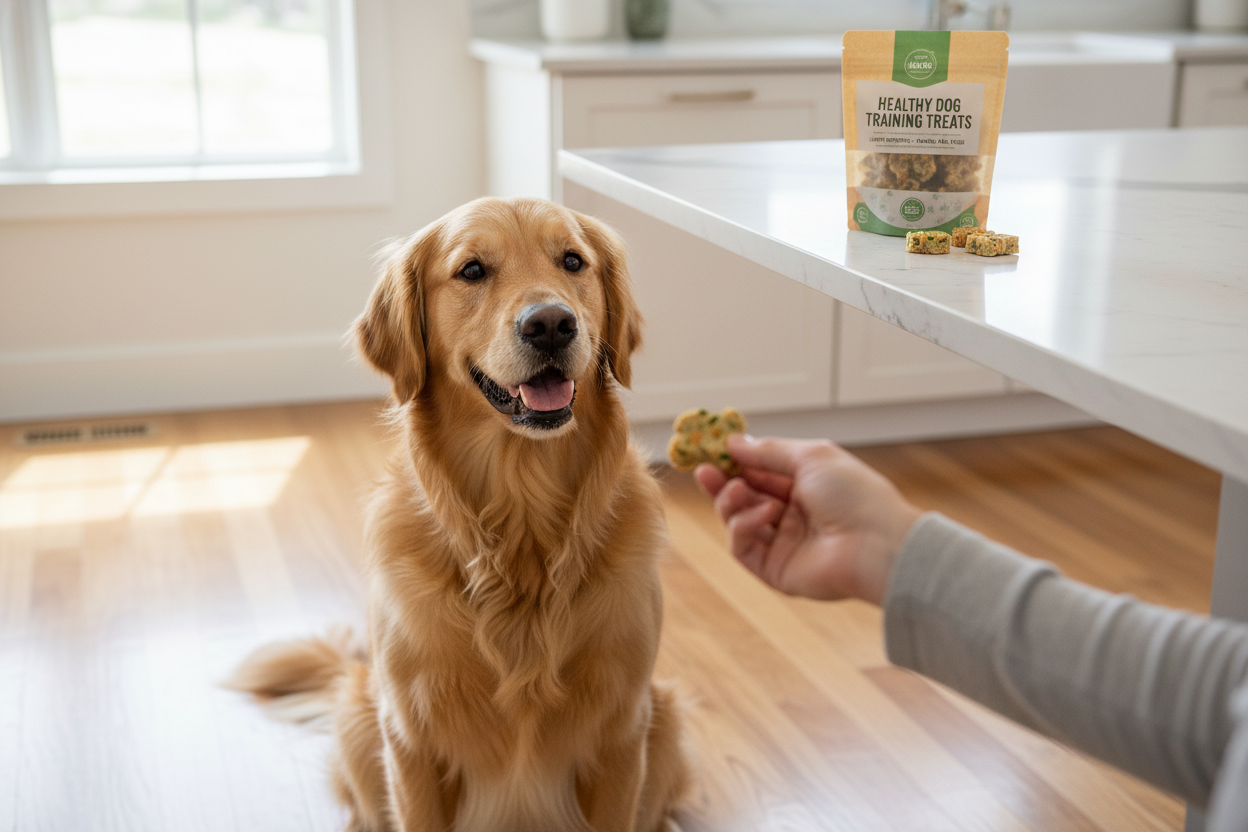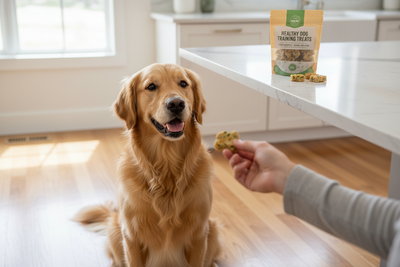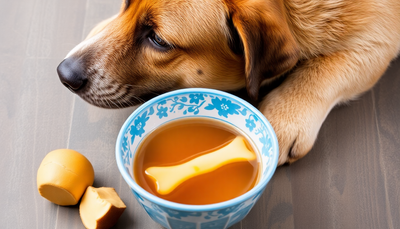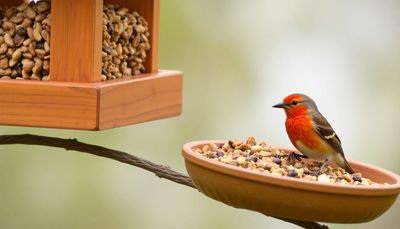The Perfect Balance: Training Success and Nutritional Support
Every dog parent knows that gleam in their pup's eyes when treats appear. That eager anticipation isn't just adorable; it's a powerful training tool. But not all treats are created equal. Using healthy dog training treats for positive reinforcement doesn't just improve your training sessions—it supports your dog's overall wellbeing while teaching them valuable behaviors.
Whether you're working with a new puppy or helping your adult dog master advanced commands, the quality of your training rewards matters significantly. Today's conscientious pet parents understand that what goes into their dog's body impacts everything from energy levels to longevity. Let's explore how nutritious training treats can transform your training approach while keeping your furry friend in optimal health.
The Science Behind Treat-Based Training
Positive reinforcement training works because it taps into fundamental learning principles. When your dog performs a desired behavior and immediately receives something they value (like a tasty treat), they're more likely to repeat that behavior. This approach creates positive associations with both the behavior itself and the training experience.
The effectiveness of treat-based training relies on several key factors:
Timing: Rewards must come immediately after the desired behavior
Consistency: Clear patterns help dogs understand expectations
Value: The reward must be something your dog genuinely wants
Health impact: Nutritional quality affects your dog's ability to learn and perform
Why Healthy Treats Enhance Learning
Healthy dog training treats offer advantages that extend beyond simple motivation. Quality ingredients support brain function, energy levels, and focus—all crucial elements for successful training sessions.
When dogs consume nutritionally balanced treats with real, wholesome ingredients, they experience more stable blood sugar levels. This translates to consistent energy and better concentration during training. In contrast, treats filled with artificial ingredients, excessive sugars, or low-quality fillers can cause energy spikes followed by crashes, making it harder for your pup to focus on learning.
Additionally, some healthy treat ingredients actively support cognitive function. Omega-3 fatty acids, for instance, promote brain health and may improve a dog's ability to learn and retain commands. Antioxidants help protect brain cells from damage, potentially supporting better cognitive performance as your dog ages.
Choosing Nutritious Training Rewards
The treat aisle can be overwhelming with countless options claiming to be "natural" or "healthy." To make truly beneficial choices for your training sessions, focus on these key considerations:
Ingredient quality: Look for treats with real, recognizable ingredients
Nutritional balance: Consider protein content, healthy fats, and limited carbohydrates
Size appropriateness: Small, low-calorie options work best for frequent rewarding
Palatability: Even healthy treats must be enticing enough to motivate your dog
When selecting healthy dog training treats, consider your specific training goals. For extended training sessions, you might want treats that are slightly larger or more substantial. For rapid-reward scenarios like clicker training, tiny, soft treats allow for quick consumption and continued focus.
Reading Labels: What to Look For and Avoid
Becoming label-savvy is essential for choosing truly healthy dog training treats. Here's what to prioritize:
Seek out these positive indicators:
Named animal protein sources (like "chicken" or "beef" rather than "meat")
Limited ingredient lists with recognizable foods
Natural preservatives like vitamin E (mixed tocopherols)
Functional ingredients that support health (omega fatty acids, glucosamine, etc.)
Appropriate protein levels for your dog's life stage and activity level
Avoid treats containing:
Artificial colors, flavors, or preservatives
Excessive salt or sugar
Generic "meat by-products" or "animal digest"
Fillers like corn, wheat, or soy (especially for dogs with sensitivities)
Propylene glycol or BHA/BHT preservatives
Many quality treats will also indicate if they're grain-free, limited-ingredient, or formulated for specific health concerns. While these specialized options aren't necessary for all dogs, they can be valuable for pets with allergies or sensitivities.
Smart Training Techniques with Healthy Treats
Even the healthiest treats should be used strategically during training. Effective treat-based training involves more than simply handing over rewards—it requires thoughtful implementation.
Start by establishing a clear value hierarchy among treats. Reserve "high-value" healthy treats (typically those with stronger aromas and flavors) for teaching new behaviors or working in distracting environments. Use "medium-value" treats for reinforcing known behaviors or practicing in familiar settings.
Timing matters tremendously. Deliver the treat within 1-2 seconds of the desired behavior to create a clear connection between action and reward. This immediate feedback helps your dog understand exactly which behavior earned the treat.
As your dog masters commands, gradually transition to intermittent reinforcement—rewarding some instances of the behavior rather than every single one. This approach actually strengthens the behavior while reducing treat dependency.
Portion Control While Maintaining Effectiveness
One common concern with treat-based training is calorie intake. Fortunately, you can maintain effectiveness while practicing smart portion control:
Break treats into smaller pieces—most dogs respond to the frequency of rewards rather than size
Account for training treats in your dog's daily caloric intake by slightly reducing regular meals
Use a portion of your dog's regular kibble as training rewards for basic behaviors in low-distraction environments
Incorporate non-food rewards like play, praise, or petting for some behaviors
Choose treats specifically formulated to be low-calorie but high-value
For intensive training periods, consider treats with higher nutritional density and lower calorie counts. Many brands now offer "training-specific" healthy dog training treats designed precisely for frequent rewarding without overfeeding.
Beyond Treats: Creating a Comprehensive Training Approach
While healthy dog training treats form the foundation of positive reinforcement, a holistic training approach incorporates multiple elements:
Verbal markers: Pair treats with consistent verbal cues like "good" or "yes" to eventually reduce treat dependency while maintaining the positive association.
Clicker training: This precise marking system helps dogs understand exactly which behavior earned the reward, making training more efficient.
Environmental management: Set your dog up for success by controlling the environment to make desired behaviors easier and undesired ones more difficult.
Consistency across family members: Ensure everyone uses the same commands, reward timing, and expectations to prevent confusion.
When combined with nutritious, appropriate treats, these techniques create a comprehensive training system that respects your dog's physical and psychological wellbeing.
Healthy Treat Options for Special Needs
Many dogs have specific dietary requirements that must be considered when selecting training treats:
For weight management: Look for treats with fewer than 3-5 calories per piece, or consider using fresh vegetables like baby carrots or cucumber slices.
For sensitive stomachs: Single-ingredient treats or limited-ingredient formulas with novel proteins may reduce digestive upset.
For older dogs: Softer treats with joint-supporting ingredients like glucosamine can be both motivating and beneficial.
For puppies: Select treats specifically formulated for growing dogs, with appropriate calcium-phosphorus ratios and developmental nutrients.
Always consult your veterinarian before introducing new treats if your dog has medical conditions, food sensitivities, or is on a therapeutic diet.
Transforming Training Through Better Nutrition
Healthy dog training treats represent the perfect intersection of effective training and responsible pet care. By choosing high-quality, nutritious options, you're not making a compromise—you're enhancing both aspects simultaneously.
The benefits extend far beyond the training session itself. When you use wholesome treats, you're supporting your dog's immune system, digestive health, energy levels, and cognitive function. This creates a positive cycle: better health leads to improved learning capacity, which leads to more successful training outcomes.
Remember that positive reinforcement with healthy treats builds more than just obedience—it strengthens the bond between you and your dog. Each training session becomes an opportunity to communicate, connect, and build trust through positive experiences.
By investing in quality training treats and using them wisely, you're setting the foundation for a well-behaved, healthy companion who associates learning with joy rather than stress. Start incorporating these nutritious rewards today, and watch as both your training success and your dog's wellbeing flourish together.






